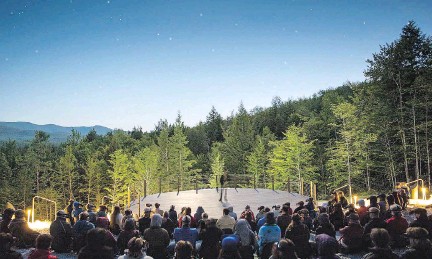The way Jeremy Fontana tells it, the next big thing in stargazing might just be a concept dreamed up in the bucolic village of Glen Sutton in the Eastern Townships.
Fontana is the co-owner of Au Diable Vert, a wilderness resort in Glen Sutton, and is the driving force behind what he is calling “the world’s first open-air augmentedreality planetarium.”
The National Geographic ObservÉtoiles is a high-tech outdoor stargazing show where you wear augmented-reality headsets that allow you to look at the planets and stars and also see 3D digital representations of the sky action.
It launched in late June at a natural amphitheatre on the south side of Mont Sutton, at an altitude of 1,000 feet, with 184 heated seats. There will be an astronomer on stage every night to walk the audience through the star show. The shows have been in French so far; the first one in English is set for Thursday, Aug. 2 at 9 p.m.
For years, Fontana has marvelled at the fantastic view of the night sky from Au Diable Vert and wondered how they could better capitalize on it.
“One of the neat things about us is, because we face south into the Green Mountains, any light pollution from even Sutton or Cowansville or Montreal is hidden by the summit of Mont Sutton,” Fontana said by phone.
Fontana used to work in the advertising milieu in Montreal, but dropped out of city life 13 years ago to take over Au Diable Vert.
“We’re in an extraordinarily dark area,” he said. “You can see the colours of the different planets and stars. You can see five or six satellites a night. It’s absolutely
exceptional. So over the years we’ve been trying to increase the appreciation of this incredible night sky. We had telescope evenings and we were selling star maps.
“I always thought there’s got to be a better way to demystify the night sky. I started to apply my advertising strategist skills to this, and I joked to many people. I said: ‘You know what space needs? It needs a better ad agency.’ “
That’s when Fontana hit on the idea of augmented reality to intensify the night sky experience. He went to a conference in California and came back convinced that was just the ticket for stargazing in Sutton.
You get augmented-reality headsets as part of the price of admission, and they allow you to see 3D digital renderings of the planets, stars and constellations while you’re looking up at the sky. The digital renderings line up exactly with the real objects.
Later in the show, they use a high-powered astronomical laser to point into the sky and show the real stars in even clearer form.
“It’s so high-powered that we had to get special permission from Transport Quebec,” said Fontana. “They actually declared the whole area around us a no-fly zone (for low-flying planes). These are the lasers that can really interfere with pilots.”
They have sold 2,200 tickets in the first month, and the Saturday shows always sell out. Tickets cost $45.99, but you can take the headset home and they give you a code so you can download the show’s app.
Au Diable Vert spent $800,000 developing the star show, including buying 10,000 headsets. You can’t buy the app used in the show without coming and getting the download code from them.
“Nobody’s ever tried to do this before,” said Fontana. “It’s the first in the world.”
National Geographic contributor Andrew Fazekas, popularly known as the Night Sky Guy, helped develop the show with Fontana. When it was almost ready, he told Fontana he should pitch it to National Geographic. The folks at the company’s headquarters in Washington loved the concept, and they partnered with Fontana to sell the technology to national parks and cruise lines around the world.
“It was completely conceived in Glen Sutton, completely developed without National Geographic, and then we came up with a worldwide licensing deal to export the concept — the headset, the app, the scripting — to national parks, cruise lines, resorts,” said Fontana.
“So we’re just in the process of launching it worldwide.”
Outside Quebec, it will be called Night Sky Odyssey.









